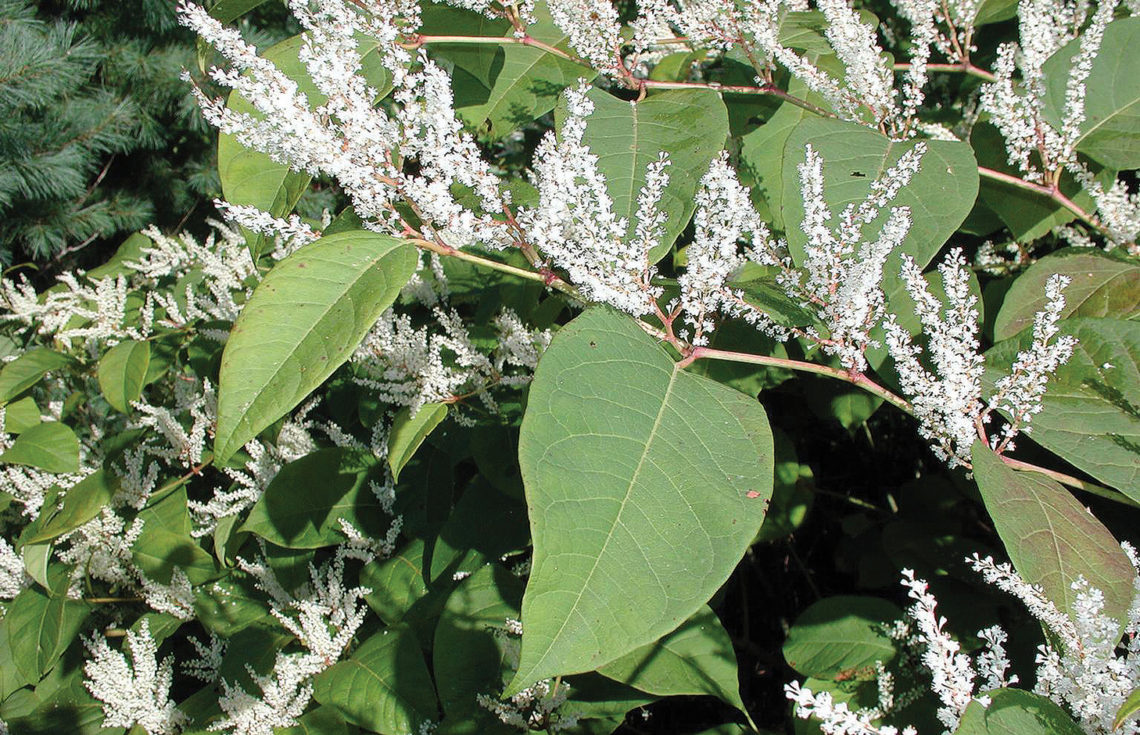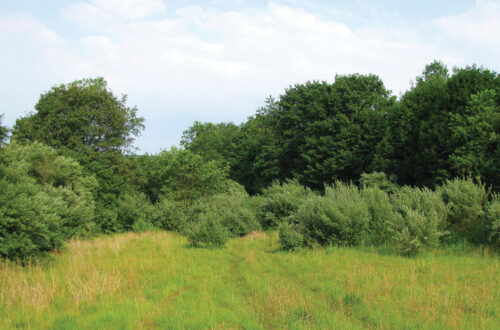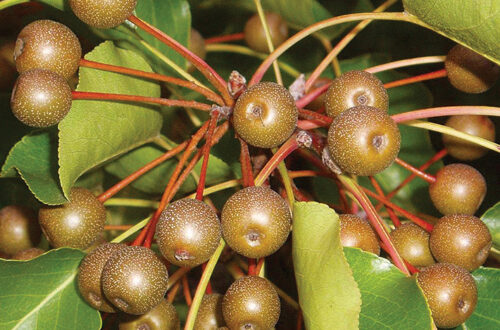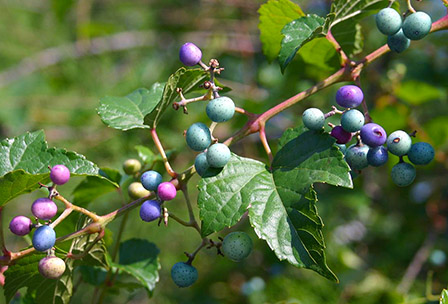SEPT-OCT 2018 – Japanese knotweed (Polygonum cuspidatum, Fallopia japonica) is sometimes called Mexican Bamboo but is neither. It’s native to Eastern Asia and has many common names including Hancock’s curse, Himalayan fleece vine, monkeyweed, tiger stick and donkey rhubarb.
History
According to the University of Leicester, it arrived at the Royal Botanic Gardens Kew in August 1850 in an unsolicited package of plants from Philippe von Siebold in Holland. Japanese knotweed was subsequently sold by nurserymen all over the Britain where it was used as an ornamental, for cattle forage and to stabilize riverbanks.
Its use was promoted by William Robinson (1838-1935) the author of The Wild Garden (1870) and The English Flower Garden (1883).
Robinson was an early proponent of mixed borders and the wild gardening movement and went against Victorian practice by advocating informal designs and the use of new exotic species.
North America
Japanese knotweed was introduced to North America in the late 1800s as an ornamental as well as for erosion control and landscape screening. According to the USDA, it’s now present in 42 states.
It’s considered invasive in Connecticut because it’s fast growing and forms dense stands that shade out native plants and reduce wildlife habitat and biodiversity. It will also explore weaknesses in structures and underground pipes.
It’s a threat to riparian areas because it can withstand flooding and colonize islands and stream banks creating a monoculture. It has an extensive root system that can extend 45-60 feet.
As if all this isn’t enough, Japanese knotweed is reportedly allelopathic, it produces compounds that inhibit the growth of other plants.
Identification
Japanese knotweed is a multi-stemmed herbaceous perennial shrub that can reach a heights of 10 feet or more. The green stems are hollow, mottled with red/purple flecks and have a zig zag appearance.
The stem is raised at the nodes, similar to bamboo, and may have ocrea (a sheath on the stem at the nodes). The ocrea may be small or missing, especially on older plants.
The simple ovate leaves, which are arranged alternately, are about 3-6 inches long and 2-5 inches wide. The leaves, which appear in April, have a squarish base and a pointed tip.
Small lacey white flowers appear on 4-5 inch long panicles arising from leaf axils in late summer. These plants are dioecious, female and male flowers occur on separate plants.
The plants turn brown and die with the onset of frost. The leaves turn a distinctive coppery brown and are easily spotted once you know what they look like.
Habitat
Japanese knotweed readily invades disturbed areas, such as roadsides, wetlands and stream banks that get plenty of sun. It’s tolerant of road salt and compacted soil. It prefers a moist environment and sun.
Reproduction
Reproduction is primarily vegetative through rhizomes and shoot fragments. Female plants produce small (.033 inch) triangular, winged seeds that can be dispersed by wind and water.
Look-alikes
Japanese knotweed resembles giant knotweed (Polygonum sachalinense, Fallopia sachalinensis), but giant knotweed is larger, has greenish flowers and heart-shaped leaves. Giant knotweed is also considered invasive in Connecticut.
To complicate matters, the two species hybridize in the wild to create Bohemian knotweed (Polygonum x bohemicum), which can be even more problematic than either of its parents.
Invasivores Take Note
The young shoots of Japanese knotweed are edible. They can be boiled and served like asparagus. It can be substituted for rhubarb or used to make a jam by boiling the rind with sugar and pectin. I’ve also seen recipes for salsa, muffins and wine. And, of course, you can pickle it or use it to make tea. The roots contain anti-oxidants and are used in Chinese medicine.
Control & Management
The best approach is to prevent it from establishing itself in the first place.
If you don’t want to use chemicals, small stands can be cut above ground (below the first node, before the plant flowers) repeatedly until the plant starves. Place the plant material in a black plastic bag and dispose of it in the regular trash. You can also try solarization … covering the area with black plastic.
If all else fails, you can cut the stems and paint them with herbicide. Foliar applications should be used on new leaves after the stems have been cut back.
The best time to use herbicides is late summer or early fall when nutrients are being sent to the roots and rhizomes.
Young plants that have grown from seed can be pulled but you need to get everything – roots, rhizomes and all. Any fragments a half-inch or larger can resprout. It may take three years to eradicate a small patch.
Digging up the roots of larger plants, and those that have grown from rhizomes, may actually help it spread. Rhizomes can survive in the soil for decades.
Given all this, the eradication of large-scale incursions is probably beyond the scope of the average person.
The key to dealing with large stands is controlling the rhizomes. This usually includes above-ground cutting, at least three times a season, in conjunction with the foliar application of an herbicide such as triclopyr.
If you’re working near water you’ll need to use products specifically formulated for that purpose and you may even require a permit. CT DEEP has a fact sheet with instructions on the CIPWG website. Follow the directions on the label carefully, the label is the law.
Biocontrol
According to the National Park Service a psyllid (Aphalara itadori) has been found suitable for use in controlling Japanese knotweed, giant knotweed and their hybrid, Bohemian knotweed. Itadori is the Japanese name for Japanese knotweed.
Check out the CIPWG website at cipwg.uconn.edu for more information.
– Will Rowlands















